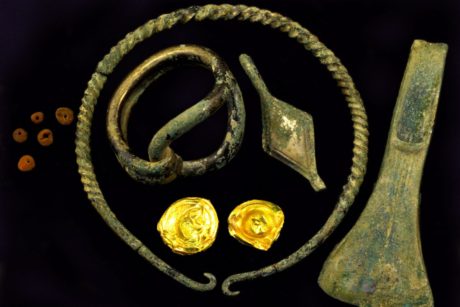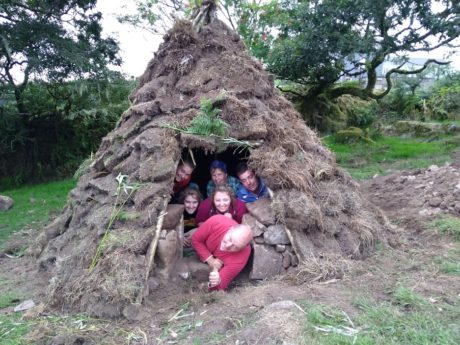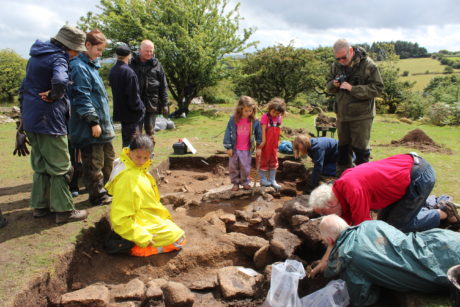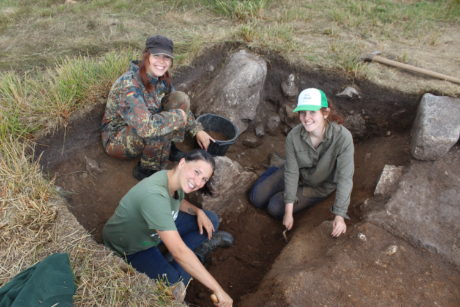
During the Bronze Age, people started doing something that today might seem quite strange: they gathered up their precious objects and buried them in the ground, with absolutely no intention of coming back for them.
We know this because many of the artefacts have been intentionally bent, broken or otherwise ‘decommissioned’ – they could never be used again. Many were also placed in or near water, not exactly the kind of place you’d put something for safe-keeping!
This practice occurred widely throughout Bronze Age Britain, peaking between c.1000-800 BC, but continuing into the Iron Age and even into the Roman period. And as archaeologists and metal detectorists continue continue working together, more and more hoards are being found, reported and investigated. Over 350 have been found in England alone. Each one is different, and each one tells us a little bit more about Bronze Age life in Britain, and its connectedness to life in Continental Europe.
In fact, one of our own crowdfunded excavations was triggered when metal detectorists found the Lancaster and Morecambe Hoards just a few miles apart. While there are hundreds of hoards around the UK, very few have been reported in North West England. Almost by default, the Lancaster and Morecambe hoards are two of the most important Bronze Age discoveries in the region.
This September, we put them on on public display for the very first time, along with some of the other discoveries from our excavations, and you can now see them for yourself in our Virtual Museum. To celebrate, here’s a few more of our favourite Bronze Age hoards from around the nation:
1. The One That’s The Biggest
![]()
© WikiCommons
Isleham Hoard, Late Bronze Age, c. 1000 BC, Cambridgshire, England
The Isleham Hoard is by far and away the largest Bronze Age hoard ever discovered in England, and it contains over 6,500 objects packed into an enormous ceramic jar. As you’d expect, there are swords, there are spear-heads, there are arrows, there are axes, palstaves, knives, daggers, armour, decorative horse gear, and many fragments of sheet bronze. The one thing it doesn’t have is a really good picture of it all! Not to worry, that just means you’ve got a really good excuse to go and see it in the flesh at West Stow Country Park.
2. The One That’s A Bit Woolly
![]()
© National Museums Scotland
St Andrews Hoard, Late Bronze Age, c. 950-750 BC, Fife, Scotland
Bronze Age hoards don’t just contain bronze artefacts. Several Scottish hoards from this period also contain rather more exotic materials, like Irish gold, Yorkshire jet and even Baltic amber, suggesting they had contact with relatively far flung places. However, the most remarkable thing about the St Andrews Hoard is not the its exotic contents, but the unusually good preservation conditions, which enabled archaeologists to recover rare pieces of textiles and organic materials, including leather, yarn, string, wood, and tusk. They even found a piece of Bronze Age wool, woven in a tabby weave. This is so rare that it’s one of only three such pieces ever found! Yes, we might think Bronze Age hoards are dominated by shiny metal objects, like weapons and jewellery, but as this one goes to show, things made of organic materials were probably included far more often than we realise.
3. The One That’s Really Early
![]()
© National Museums Scotland
Migdale Hoard, Early Bronze Age, c. 2250-1950 BC, Sutherland, Scotland
The Migdale Hoard dates all the way back to a time when bronze was first being made in the British Isles. It includes a bronze axe, but like the St Andrews Hoard, it also contains some rather more fascinating items; some bronze hair ornaments, a pair of bronze bangles or anklets, and several pieces of a woman’s elaborate headdress. Although the headdress is pretty fragmented, it is very similar to some from central North-European, with strips of bronze, little bronze cones, and some bronze beads with wooden cores. But most enchantingly, the hoard also contains a handful of Early Bronze Age buttons! These buttons, which have V-shaped holes, were a widespread early Bronze Age fashion across much of Europe, and were probably used for fastening clothes or pouches, or as decorative studs sewn on to a garment for show. One of the buttons is made of Yorkshire jet, while the other five are made of local cannel coal. Two of them have faint traces of lines marking out a cruciform design. Cute.
4. The One That’s Most Continental
![]()
© British Museum
Near Lewes Hoard, Middle Bronze Age, c. 1400-1250 BC, Sussex, England
If the St Andrews and Migdale Hoards had left you in any doubt, the Near Lewes Hoard makes it really obvious that, from Britain to the Baltic to the Iberian peninsular, Bronze Age people were very well connected. Like the Isleham Hoard, this one was found inside an earthenware vessel, and packed with over 79 objects, including 3 bronze palstaves, 5 bronze bracelets, a delicately coiled necklace, 8 bronze finger rings, 4 bronze tutuli (also known as Monkswood ornaments), 4 gold discs, 1 bronze pin, 19 amber beads and 4 bronze torcs. Some objects (like the palstave axes) were widespread across Southern England, but others (like the Sussex Loop’ bracelets pictured here) are local to Brighton. The integration of these local or regionally-produced items with rare and exotic objects like amber beads from the Baltic, gold decorative discs normally confined to France and special ‘tutuli’ type mounts produced in Germany again show what a connected world Bronze Age people lived in. In fact, our own Bronze Age specialist Ben Roberts said the Near Lewes Hoard is ‘the most spectacular and overtly continental manifestation of a distinct region of Middle Bronze Age ‘ornament horizon’ hoards…’ (PAS Specialist Report 2011T192, p13).
5. The One That’s The Most Ritual
![]()
© Marcus Abbott
Flag Fen, Middle Bronze Age to Early Iron Age, c. 1350-150 BC, East Anglia, England
Hoards weren’t always buried in one go, some of them accumulated over time at what archaeologists call ‘depositional sites’, where rituals and memorial practices are were carried out for centuries, if not millennia. Flag Fen is probably the best known. Around 3,500 years ago, people built a 1km long timber causeway across a vast area of wet fenland. Constructed from about 60,000 upright timbers, it stretches over the wetland between Fengate and Northey Island, where a number of burial mounds have been discovered, including swords, spearheads, daggers, pins, rings, brooches, and gold earrings, as well as a collection of chisels, punches and awls, which may represent an individual craftsperson’s toolkit. Judging by the types of objects recovered, the deposition of artefacts continued at this location for over 1,200 years.
6. The One That’s Stuffed With Gold
![]()
© WikiMedia Commons
Rossett Hoard, Late Bronze Age, 1000-800 BC, Wrexham, Wales
The hoard contains a faceted axe, a tanged knife, and four pieces of gold bracelet. Made from gold of Irish origin, the bracelet pieces were only discovered while conservators were examining the inside of the axe. The deliberate decommissioning of axes by plugging their sockets with small fragments is a phenomenon seen across Britain (at least 60 examples have been identified), and Europe. This is the first recorded knife of this design to be found in Wales. The gold shows that the owner had trading or personal contacts beyond this area.
7. The One That Smells The Sweetest
![]()
© Portable Antiquities Scheme / DigVentures
Lancaster Hoard, Late Bronze Age, 1150-800BC Lancashire, England
Bronze Age hoards are found all over the country, right? Well, until very recently, hardly any had actually been found in North West England. This was one of the first. It might only contain 16 objects, but it’s what’s inside that counts! As well as axes, blades, spearheads and bracelets, this hoard contained something even more spectacular… Yes, from inside one of the axe handles, conservators pulled a perfectly preserved Bronze Age flower! Analysts now think it’s likely to be meadowsweet, a strong-smelling flower that can be used to make medicines, and make rooms smell nice. You can see the entire collection in our Virtual Museum.
8. The One That Belonged To A Prehistoric Scrap Dealer
![]()
© 100 Objects That Made Kent
Boughton Malherbe Hoard, Late Bronze Age, c.850 BC, Kent, England
Containing 352 pieces, this hoard is the third largest Bronze Age ever found in Britain, after the Isleham Hoard (6,500 pieces) and the Langton Matravers hoard (777 pieces). But that is not the most remarkable thing about it. We’ve already mentioned that many artefacts in Bronze Age hoards appear to have been intentionally broken, bent or damaged as part of their burial, but the Boughton Malherbe Hoard represents something a bit different. Rather, archaeologists believe its contents represent the existence of a sophisticated, international prehistoric recycling industry. Yes, really! Many of the objects appear to have originated in northern France and the Atlantic coast of Continental Europe, but others appear to have been made in southern Wales about a century earlier and exported across the western reaches of the channel to France, before somehow making it back into England from the other direction about 100 years later. It has been suggested that on the Continent, people were already shifting to Iron and shipping their scrap back across the Channel where it was hungrily re-used by bronze smiths serving the dense network of communities in the Thames Valley and East Anglian Fenlands. Impressive.
9. The One From Under The Sea
![]()
© British Museum
Salcombe Hoard, Middle-Late Bronze Age, 1300-800 BC, Devon, England
Many hoards were (intentionally) placed in or near water, particularly river heads. Not so, the Salcombe hoard! This unique collection of 320 gold, copper alloy and tin objects was recovered from a wreck on the seabed off the coast of Salcombe, Devon. The artefacts some delectable treasures, including an eight-stranded braided-wire torque, two rolled-up ribbon torques, and part of a twisted bar torque, the likes of which had not been found in England before. But most importantly for archaeologists, the wreck also included tin ingots, the only ones found in Western Europe, finally providing the first direct evidence of long-distance tin trade during the era, and shedding brand new light on our understanding of the trade links during the Bronze Age.
10. The One With The Most Wheels (And Sea Shells!)
![]()
© British Museum
Heathery Burn, Late Bronze Age, 1000-750 BC, County Durham, England
So we know that many hoards were deposited in watery locations, but this one was deposited in a river, INSIDE A CAVE! The cave extends more than 150m underground, and through it flows Heathery Burn, about a mile north of the River Wear. The nearly 200 finds are now mostly in the British Museum, including bronze swords, axe-heads, spearheads, knives, horse fittings, rings, a razor, and a bucket; a bracelet and lock-ring of gold; objects of carved bone, antler, tooth and sea-shell; lots of pottery (now mostly lost) and a few flints. The inclusion of these sea shells is quite unusual, and demonstrates links with coastal communities, presumably on the North Sea. Whether they came to the cave themselves, or simply exchanged the items with people inland is unclear. But of extra special interest are the eight bronze ‘nave-bands’ which archaeologists think were mounted on the hubs of wheels of carts or chariots. Until the recent Must Farm discoveries, these represented the earliest known evidence for wheels in Britain. Extraordinary!
This article was originally published on digventures.com


